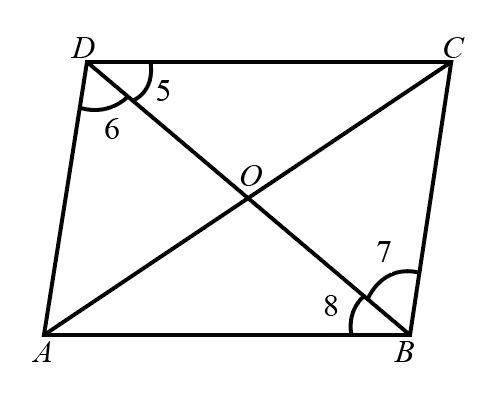
$ABCD$ is a rhombus. Show that diagonal $AC$ bisects $\angle A$ as well as $\angle C$ and diagonal $BD$ bisects $\angle B$ as well as $\angle D$.
Answer
576k+ views
Hint: All the sides of a rhombus are equal and the opposite sides are parallel to each other. Also, in a rhombus the angles opposite to equal sides are always equal.
Complete step by step solution:
The following is the schematic diagram of a rhombus.

Consider $\Delta ABC$,
Since all the sides of rhombus are equal, therefore
$AB = BC$
The angles opposite to the sides $AB$ and $BC$ will be equal. hence
$\angle 4 = \angle 2$.….(i)
Also $AD\parallel BC$ with transversal $AC$, as $AD$ and $BC$ are opposite sides of rhombus and opposite sides of rhombus are parallel to each other. Hence alternate angles will be equal.
$\angle 1 = \angle 4$……(ii)
From equation (i) and (ii).
$\angle 1 = \angle 2$
Hence, it is clear that $AC$ bisects the angle $\angle A$.
Now $AB\parallel DC$ with transversal $AC$, as $AB$ and $DC$ are opposite sides of rhombus and opposite sides of rhombus are parallel to each other. Hence alternate angles will be equal.
$\angle 2 = \angle 3$……(iii)
From equation (i) and (iii).
$\angle 4 = \angle 3$
Hence, it is clear that $AC$ bisects the angle $\angle C$.
Therefore $AC$ bisects angles $\angle A$ and $\angle C$.
Since $CD$ and $BC$ are the sides of rhombus, therefore $CD = BC$.
The following is the schematic diagram of a rhombus.

The angles opposite to the sides $CD$ and $BC$ will be equal. hence
$\angle 5 = \angle 7$..….(iv)
Also $AB\parallel CD$ with transversal $BD$ , as $AB$ and $CD$ are opposite sides of rhombus and opposite sides of rhombus are parallel to each other. Hence alternate angles will be equal.
$\angle 5 = \angle 8$……(v)
From equation (iv) and (v).
$\angle 7 = \angle 8$
Hence $BD$ bisects the angle $\angle B$.
Now $AD\parallel BC$ with transversal $BD$, as $AD$ and $BC$ are opposite sides of rhombus and opposite sides of rhombus are parallel to each other. Hence alternate angles will be equal.
$\angle 6 = \angle 7$……(vi)
From equation (v) and (vi).
$\angle 5 = \angle 6$
Hence $BD$ bisects the angle $\angle D$.
Therefore $BD$ bisects angles $\angle B$ and $\angle D$.
Note: Angle bisector divides the angle in two equal angles. Make sure to use the properties of rhombus in the solution.
Complete step by step solution:
The following is the schematic diagram of a rhombus.

Consider $\Delta ABC$,
Since all the sides of rhombus are equal, therefore
$AB = BC$
The angles opposite to the sides $AB$ and $BC$ will be equal. hence
$\angle 4 = \angle 2$.….(i)
Also $AD\parallel BC$ with transversal $AC$, as $AD$ and $BC$ are opposite sides of rhombus and opposite sides of rhombus are parallel to each other. Hence alternate angles will be equal.
$\angle 1 = \angle 4$……(ii)
From equation (i) and (ii).
$\angle 1 = \angle 2$
Hence, it is clear that $AC$ bisects the angle $\angle A$.
Now $AB\parallel DC$ with transversal $AC$, as $AB$ and $DC$ are opposite sides of rhombus and opposite sides of rhombus are parallel to each other. Hence alternate angles will be equal.
$\angle 2 = \angle 3$……(iii)
From equation (i) and (iii).
$\angle 4 = \angle 3$
Hence, it is clear that $AC$ bisects the angle $\angle C$.
Therefore $AC$ bisects angles $\angle A$ and $\angle C$.
Since $CD$ and $BC$ are the sides of rhombus, therefore $CD = BC$.
The following is the schematic diagram of a rhombus.

The angles opposite to the sides $CD$ and $BC$ will be equal. hence
$\angle 5 = \angle 7$..….(iv)
Also $AB\parallel CD$ with transversal $BD$ , as $AB$ and $CD$ are opposite sides of rhombus and opposite sides of rhombus are parallel to each other. Hence alternate angles will be equal.
$\angle 5 = \angle 8$……(v)
From equation (iv) and (v).
$\angle 7 = \angle 8$
Hence $BD$ bisects the angle $\angle B$.
Now $AD\parallel BC$ with transversal $BD$, as $AD$ and $BC$ are opposite sides of rhombus and opposite sides of rhombus are parallel to each other. Hence alternate angles will be equal.
$\angle 6 = \angle 7$……(vi)
From equation (v) and (vi).
$\angle 5 = \angle 6$
Hence $BD$ bisects the angle $\angle D$.
Therefore $BD$ bisects angles $\angle B$ and $\angle D$.
Note: Angle bisector divides the angle in two equal angles. Make sure to use the properties of rhombus in the solution.
Recently Updated Pages
Why are manures considered better than fertilizers class 11 biology CBSE

Find the coordinates of the midpoint of the line segment class 11 maths CBSE

Distinguish between static friction limiting friction class 11 physics CBSE

The Chairman of the constituent Assembly was A Jawaharlal class 11 social science CBSE

The first National Commission on Labour NCL submitted class 11 social science CBSE

Number of all subshell of n + l 7 is A 4 B 5 C 6 D class 11 chemistry CBSE

Trending doubts
What is meant by exothermic and endothermic reactions class 11 chemistry CBSE

10 examples of friction in our daily life

One Metric ton is equal to kg A 10000 B 1000 C 100 class 11 physics CBSE

1 Quintal is equal to a 110 kg b 10 kg c 100kg d 1000 class 11 physics CBSE

Difference Between Prokaryotic Cells and Eukaryotic Cells

What are Quantum numbers Explain the quantum number class 11 chemistry CBSE




